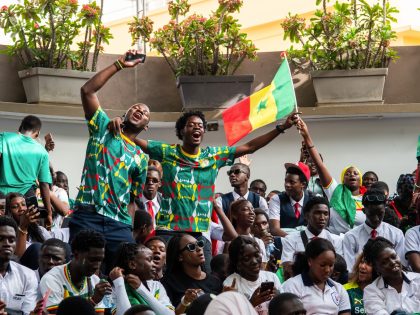The Black Messiah
John Coltrane was a prophet of global black power who musically and metaphorically broke down barriers constraining the lives and imaginations of black people worldwide.

In the liner notes of his newest record – the artist’s first in 14 years – neo soul virtuoso D’Angelo acknowledges the obvious: “Black Messiah is a hell of a name for an album.” Among the many reasons for the title’s resonance is that the figure it imagines – a messianic leader for the black community – is such a tantalizing and hopeful notion. With the flames of protest still smoldering across the US, the need for a black messiah feels as urgent as ever. Many have cast D’Angelo for the part, but he’s been loath to assume his own audacious title, explaining that “the title is about all of us.” Perhaps the artist rejects the idea of a singular black savior who speaks through music – one whose songs provide a profound sense of political and spiritual salvation for listeners. Or maybe he realizes that the position is already taken.
This month marks the fiftieth anniversary of the release of John Coltrane’s A Love Supreme, an album that elevated the saxophonist to quasi-divine status. In Coltrane’s life and work, we see the burden African-American artists have carried beyond their artistry, particularly in times of social upheaval. For many, Coltrane was, and remains, a prophet of global black power who musically and metaphorically broke down barriers that had constrained the lives and imaginations of black people worldwide. Coltrane’s emergence in the Fifties and Sixties coincided with the growth of anti-colonialist Black Nationalism in Africa and Latin America, the Civil Rights movement in the United States, and demands for equality worldwide. Given this context, his music revolution could not help but become entwined with the broader social struggle. Although Coltrane never asserted publically that his music was intended as a vehicle to promote political change, his sound was so distinct, such a break from the status quo, so of the moment, that others imputed to his work political and cultural motives that continue to define him. His music served as a kind of auditory Rorschach test for its listeners. What did you hear in those riffs – politics or spirituality? Abrasiveness or empowerment? What was his responsibility as a black artist: to please the ears, soothe the soul, or get feet marching in the streets? To return to the music scene at this incendiary moment in the national debate on race, what, if anything, is D’Angelo saying about a musician’s role in that conversation?
Coltrane developed his sound in the eye of a musical maelstrom that saw young African American artists defying the rules of standard jazz, even as their contemporaries were challenging societal norms. Coltrane played first with Dizzy Gillespie and then with Miles Davis before stepping out as a truly independent voice in 1960 when Atlantic Records released Giant Steps, the first recording on which he was the lead musician for the label. Coltrane’s break from bebop with Giant Steps was so revolutionary that other jazz musicians at the time embraced it as the essence of “freedom.” Coltrane kept going. That same year, he recorded the album My Favorite Things, which Atlantic released a year later. The title track reworks the song Julie Andrews sings to her charges in Rodgers and Hammerstein’s “The Sound of Music;” it is difficult to imagine a song having two more different iterations and faces. In the quartet’s rendition, accented by Coltrane’s relentless soloing, a distinctly white song becomes a composition rich with blues, pain, joy, and abandon. Coltrane’s Favorite Things was a revolution on the stage that reflected and refracted the revolution in the streets.
Not everyone was enamored immediately with Coltrane’s new sound. Nat Hentoff, the historian and jazz critic, initially dismissed the saxophonist in terms that continue to resonate today. Like many other white reviewers, Hentoff called Coltrane’s work ‘angry’ and ‘strident;’ as some white critics heard it, Coltrane’s sound was the abrasive musical complement to the anger of the mass protests. As with any changing politics, many white reviewers had a more challenging time than their black colleagues and audiences, appreciating how Coltrane was pushing back against traditional jazz. Philip Larkin, the English poet and occasional jazz reviewer for The Telegraph, would not abide what he saw as the joyless radicalism of the new. Coltrane, he wrote, played with a “willful and hideous distortion of tone that offered squeals, squeaks, Bronx cheers and throttled slate-pencil noises for serious consideration.”
Whereas Larkin and other conservatives saw Coltrane’s innovations as a heedless rejection of the musical past, many black critics and audiences saw a vital and resonant thrust in a new direction. Many African Americans contended that the very fact of being white rendered Hentoff, Larkin, and others incapable of comprehending fully Coltrane’s music and how it was inseparable from its political context.
As the music changed, so too did politics. Coltrane mostly refrained from linking his music to contemporary events as controversy raged about his sound. After four little girls were killed by a bomb in Birmingham, Alabama’s Sixteenth Street Baptist Church in 1963, however, Coltrane could no longer hold back. Among a torrent of artistic tributes that followed that event was “Alabama,” a plaintive jazz elegy that Coltrane composed and recorded just two months later. Many claimed to hear echoes of Martin Luther King, Jr.’s eulogy for the girls in his cadence and tone. For his part, Coltrane remained coy, saying, “It represents, musically, something that I saw down there translated into music from inside me.”
Coltrane fans grew used to responses like this. When Frank Kofsky, a Marxist historian at California State University at Sacramento and an expert on jazz, asked Coltrane directly whether his music had a relationship with Malcolm X’s ideas. Coltrane replied obliquely, “Well, I think that music, being an expression of the human heart or of the human being itself, does express just what is happening. I feel it expresses the whole thing – the whole human experience at the particular time it is being expressed.” Coltrane never explained his reticence, but the jazz historian Lewis Porter, who wrote his foundational biography, told me in an interview that Coltrane was wary of the press and reluctant to appear to support any particular political approach to promoting civil rights. His apprehension stood in contrast to more directly political figures in the jazz world, like Max Roach, the great drummer who put out an album called “We Insist! Freedom Now Suite,” a collaboration with Oscar Brown, Jr. that included tracks with lyrics explicitly about slavery, the Sharpeville massacre in South Africa, and the black freedom struggle.
Yet even though Coltrane was not direct in his approach, by pushing against the constraints of previous generations of music, he was, deliberately or not, encouraging resistance to other forms of control. African American audiences and critics frequently drew parallels between his bold musical works and acts ranging from the fiery speeches of Black Nationalist leaders to nonviolent protests at lunch counters, marches, and bus terminals. For Amiri Baraka, Coltrane was a ‘Black Messiah,’ a Malcolm X of music: “Trane’s constant assaults on the given, the status quo, the Tin Pan Alley of the soul, was what Malcolm attempted in our social life.”
The poets of the Black Arts Movement brought Coltrane into the belly of political debate in both the content and form of their works. In his poem “Extension,” Askia Muhammad Toure figured Coltrane and other jazz musicians, including Sun Ra, Pharoah Sanders, and Milford Graves, as the sonic complement to Black Power:
Let the Ritual begin:
Sun Ra, Pharoah, Coltrane, Milford tune up your Afro-horns;
let the Song begin, the Wild Song of the Black Heart….
Michael S. Harper’s poem “Dear John, Dear Coltrane,” describes Coltrane as an everyman of black tragedy and longing. Harper contended that whether or not Coltrane claimed to be involved in politics, he was: it was his obligation, his inevitability. “The blues and jazz are the finest extensions of a bedrock of the testamental process,” Harper wrote, words that conferred on Coltrane the mantel of a Black Messiah.
Coltrane was not blind to his political allure. He agreed in 1960 to headline a concert for the Students for Racial Equality chapter at the University of California, for example, and although that event was never held, Coltrane’s willingness to perform signaled a desire to support political causes. Coltrane did play at other overtly political events, including eight concerts to benefit Martin Luther King, Jr. He also wrote several songs inspired by the civil rights leader, most notably “Up ’Gainst the Wall” and “Reverend King.”
In his own writings, however, it is clear that Coltrane envisioned a politics of a different order than that in which King was engaged, a politics that might transcend the social struggles of the mid-century US. In the liner notes to A Love Supreme, Coltrane wrote a very intimate admission of his personal failings, and offered the album as a plea for others to join him in a search for “spiritual awakening.” The album resonated in a deeply emotional way, particularly among African Americans. “A Love Supreme is to cultural politics as ‘I Have a Dream’ and ‘Beloved Community’ are to King’s acolytes,” says the poet Elizabeth Alexander. Coltrane’s journey – his quest for wholeness and awakening – was one that many shared. As Frank Kofsky wrote, “Coltrane’s ardent young black followers discovered in his work…the clearest possible expression of the African-American mentality in the second half of the twentieth century.” D’Angelo says the same of his own musical vision when he insists that his startling title “is about all of us.”
John Coltrane died of liver cancer on July 17, 1967. He was 40 years old. His death was easily overlooked in the litany of loss that marked the mid-1960s: Medgar, Malcolm, Martin, so many others. Yet more than a thousand people attended his funeral at St. Peter’s Lutheran Church in New York City. As his casket was borne out of the church, Ornette Coleman’s quartet played “Holiday for a Graveyard.“He ascended, and then he was gone, in 1967, as American cities burned,” says Alexander, whose 1990 poem “John Col,” celebrates and mourns Coltrane. “The seer was gone. He was a piece of all the black leadership and hope that was extinguished in the Sixties.”
That illusory sense of hope has continued to evade black Americans, even as symbols of progress abound. Cornel West seemed to be grasping for a piece of that Messianic leadership this past summer when he invoked Coltrane’s legacy in lambasting Barack Obama for failing to live up to the promise African Americans had invested in him. The people were “looking for John Coltrane,” West stated, but instead they got a “brown skinned Kenny G.” Coltrane’s own words belie West’s easy characterization of his individual value; rather, Coltrane seemed to have wanted others to join him, not look to him for salvation. D’Angelo similarly chides West and others, by claiming that the title ‘Messiah’ is best understood as a collective identity, one that does not reside within any one individual, no matter how messianic he might seem. It is a collective mantle and a collective burden. Coltrane pushed forward in search of a widespread awakening. If we are all Michael Brown and Eric Garner, then perhaps we might all strive to be John Coltrane, too.



















